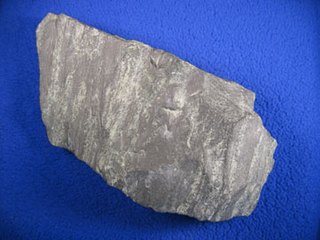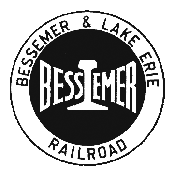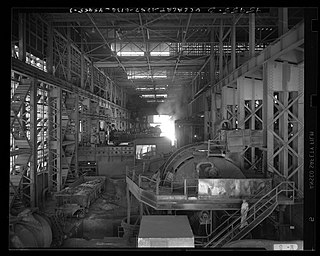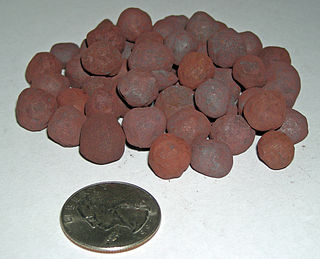Related Research Articles

Iron ores are rocks and minerals from which metallic iron can be economically extracted. The ores are usually rich in iron oxides and vary in color from dark grey, bright yellow, or deep purple to rusty red. The iron is usually found in the form of magnetite (Fe
3O
4, 72.4% Fe), hematite (Fe
2O
3, 69.9% Fe), goethite (FeO(OH), 62.9% Fe), limonite (FeO(OH)·n(H2O), 55% Fe) or siderite (FeCO3, 48.2% Fe).

The Mesabi Iron Range is a mining district in northeastern Minnesota following an elongate trend containing large deposits of iron ore. It is the largest of four major iron ranges in the region collectively known as the Iron Range of Minnesota. First described in 1866, it is the chief iron ore mining district in the United States. The district is located largely in Itasca and Saint Louis counties. It has been extensively worked since 1892, and has seen a transition from high-grade direct shipping ores through gravity concentrates to the current industry exclusively producing iron ore (taconite) pellets. Production has been dominantly controlled by vertically integrated steelmakers since 1901, and therefore is dictated largely by US ironmaking capacity and demand.

Taconite is a variety of iron formation, an iron-bearing sedimentary rock, in which the iron minerals are interlayered with quartz, chert, or carbonate. The name "taconyte" was coined by Horace Vaughn Winchell (1865–1923) – son of Newton Horace Winchell, the Minnesota State Geologist – during their pioneering investigations of the Precambrian Biwabik Iron Formation of northeastern Minnesota. He believed the sedimentary rock sequence hosting the iron-formation was correlative with the Taconic orogeny of New England, and referred to the unfamiliar and as-yet-unnamed iron-bearing rock as the 'taconic rock' or taconyte.

The Iron Range is collectively or individually a number of elongated iron-ore mining districts around Lake Superior in the United States and Canada. Much of the ore-bearing region lies alongside the range of granite hills formed by the Giants Range batholith. These cherty iron ore deposits are Precambrian in the Vermilion Range and middle Precambrian in the Mesabi and Cuyuna ranges, all in Minnesota. The Gogebic Range in Wisconsin and the Marquette Iron Range and Menominee Range in Michigan have similar characteristics and are of similar age. Natural ores and concentrates were produced from 1848 until the mid-1950s, when taconites and jaspers were concentrated and pelletized, and started to become the major source of iron production.

The Bessemer and Lake Erie Railroad is a class II railroad that operates in northwestern Pennsylvania and northeastern Ohio.

The Virginia and Truckee Railroad is a privately owned heritage railroad, headquartered in Virginia City, Nevada. Its private and publicly owned route is 14 miles (23 km) long. When first constructed in the 19th century, it was a commercial freight railroad which was originally built to serve the Comstock Lode mining communities of northwestern Nevada.

The Duluth, Missabe and Iron Range Railway (DM&IR), informally known as the Missabe Road, was a railroad operating in northern Minnesota and Wisconsin that used to haul iron ore and later taconite to the Great Lakes ports of Duluth and Two Harbors, Minnesota. Control of the railway was acquired on May 10, 2004, by the Canadian National Railway (CN) when it purchased the assets of Great Lakes Transportation.
Eagle Mountain, is a ghost town in the California desert in Riverside County founded in 1948 by industrialist Henry J. Kaiser. The town is located at the entrance of the now-defunct Eagle Mountain iron mine, once owned by the Southern Pacific Railroad, then Kaiser Steel, and located on the southeastern corner of Joshua Tree National Park. The town's fully integrated medical care system, similar to other Kaiser operations in California, was the genesis of the modern-day Kaiser Permanente health maintenance organization. Eagle Mountain is accessible by Kaiser Road from California State Route 177, twelve miles (19 km) north of Desert Center, midway between Indio and the California/Arizona state line along Interstate 10.
The Lake Superior and Ishpeming Railroad, is a U.S. railroad offering service from Marquette, Michigan, to nearby locations in Michigan's Upper Peninsula. It began operations in 1896. The LS&I continues to operate as an independent railroad from its headquarters in Marquette.
The Eagle Mountain Railroad (EMRR) was a private railroad in California, owned by the Kaiser Steel Corporation, and is owned today by Kaiser Steel's successor, Kaiser Ventures, Inc. of Ontario, California.

The Santa Fe, Prescott and Phoenix Railway (SFP&P) was a common carrier railroad that later became an operating subsidiary of the Atchison, Topeka and Santa Fe Railway in Arizona. At Ash Fork, Arizona, the SFP&P connected with Santa Fe's operating subsidiary, the Atlantic & Pacific Railroad mainline, that ran from California to Chicago. The SFP&P's 195-mile (314 km) line extended the Santa Fe Railway south into Phoenix. The SFP&P extended another 100 miles (160 km) to the east from Phoenix to Florence and Winkelman via the Phoenix and Eastern Railroad. The SFP&P also served several mines in the Prescott area, including the Derby Mine by way of the Summit (flag) Station at 'Prieta' in the Sierra Prieta range, through its various subsidiary railroads.


The Hull–Rust–Mahoning Open Pit Iron Mine in Hibbing, Minnesota, United States, is the largest operating open-pit iron mine in Minnesota. The pit stretches more than three miles (5 km) long, two miles (3 km) wide, and 535 feet (163 m) deep. It was established in 1895 and was one of the world's first mechanized open-pit mines.
Cleveland-Cliffs Inc., formerly Cliffs Natural Resources, is a Cleveland, Ohio-based company that specializes in the mining, beneficiation, and pelletizing of iron ore, as well as steelmaking, including stamping and tooling. It is the largest flat-rolled steel producer in North America.

An ore dock is a large structure used for loading ore onto ships, which then carry the ore to steelworks or to transshipment points. Most known ore docks were constructed near iron mines on the upper Great Lakes and served the lower Great Lakes. Ore docks still in existence are typically about 60 feet (18 m) wide, 80 feet (24 m) high, and vary from 900 feet (270 m) to 2,400 feet (730 m) in length. They are commonly constructed from wood, steel, reinforced concrete, or combinations of these materials.

The Mount Newman railway, owned and operated by BHP, is a private rail network in the Pilbara region of Western Australia built to carry iron ore. It is one of two railway lines BHP operates in the Pilbara, the other being the Goldsworthy railway.
The Oliver Iron Mining Company was a mining company operating in Minnesota, United States. It was one of the most prominent companies in the early decades of mining on the Mesabi Range. As a division of U.S. Steel, Oliver dwarfed its competitors—in 1920, it operated 128 mines across the region, while its largest competitor operated only 65.

Elcor is a ghost town, or more properly, an extinct town, in the U.S. state of Minnesota that was inhabited between 1897 and 1956. It was built on the Mesabi Iron Range near the city of Gilbert in St. Louis County. Elcor was its own unincorporated community before it was abandoned and was never a neighborhood proper of the city of Gilbert. Not rating a figure in the national census, the people of Elcor were only generally considered to be citizens of Gilbert. The area where Elcor was located was annexed by Gilbert when its existing city boundaries were expanded after 1969.

The Cliffs Erie Railroad was a railroad that operated from Hoyt Lakes to Taconite Harbor, Minnesota. The railroad opened in 1956 by Erie Mining Company to transport taconite from Hoyt Lakes to Taconite Harbor. In 1989, LTV Steel purchased Erie Mining and the railroad was renamed LTV Mining Railroad. The railroad closed in early 2001 when the LTV company ended the operations of the harbor. In 2002 Cleveland Cliffs bought the plant, and again renamed the railroad The Cliffs Erie Railroad. In 2004 Cliffs Erie hired a contractor to claim leftover chips and pellets from the mine due to the high iron prices. They used the only unsold locomotives, EMD F9s. The cleanup trains ran until 2008 when the last train ran. In 2014, the F9s were sold off. The railroad is now sitting, unlikely to ever see activity again.

Iron mining in the United States produced 48 million metric tons of iron ore in 2019. Iron ore was the third-highest-value metal mined in the United States, after gold and copper. Iron ore was mined from nine active mines and three reclamation operations in Michigan, Minnesota, and Utah. Most of the iron ore was mined in northern Minnesota's Mesabi Range. Net exports were 3.9 million tons. US iron ore made up 2.5 percent of the total mined worldwide in 2015. Employment as of 2014 was 5,750 in iron mines and iron ore treatment plants.
References
- 1 2 3 4 5 6 7 8 9 10 11 Sanders, Dale (September 1993). "U.S. Steel Atlantic City". CTC Board. Vol. 189. pp. 20–27.
- ↑ Thomas, Horace D. (January 1967). "Biennial Report of the State Geologist for 1965-1967: Geological Survey of Wyoming" (PDF). Wyoming State Geological Survey.
- ↑ Sanders, Dale (October 1978). "USS Atlantic City F-units vs Iron Ore". CTC Board. Vol. 40. pp. 10–11.
- ↑ "S.F. Firms Get Mine Contract". Salt Lake Tribune. June 28, 1960. p. 40.
- ↑ Ingles, J. David (February 1982). "Where did the Milwaukee go?". Trains. p. 49.
- 1 2 3 4 "The Great Ore Heist". Trains. March 1995. p. 39.
- ↑ Associated Press (August 16, 1962). "Ore on Way: Wyoming To Geneva". Salt Lake Tribune. p. B7.
- 1 2 3 4 James, Martin (September 1967). "A railroad finally made it!". Trains. pp. 27–28.
- ↑ Ambler, Marjane (March 18, 1985). "A busted Wyoming mining town remains haunted by 550 lost jobs". High Country News. p. 1. Retrieved March 18, 2018.
- ↑ "United States Steel Corporation". Social Networks and Archival Context.
- ↑ Ingles, J. David (January 1984). "Arrivals & Departures". Trains. p. 13.
- 1 2 3 Kuck, Peter H. "Iron Ore". Minerals Yearbook 1985 (PDF). pp. 517–540 – via University of Wisconsin Library.
- 1 2 3 4 Over, Ernie (June 26, 2012). "Remaining Iron Ore deposits at former Atlantic City Mine Site getting second look, Commissioners told". County 10. Archived from the original on April 6, 2018.